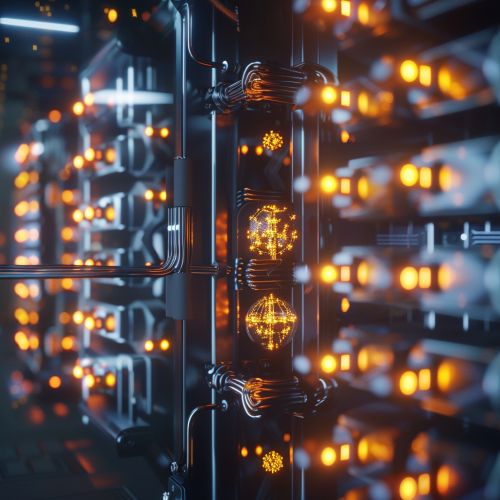Quantum Operation
Quantum Operation
A quantum operation, also known as a quantum channel, is a mathematical formalism used in quantum information theory to describe the evolution of quantum states. It generalizes the concept of quantum gates and measurements, providing a comprehensive framework for understanding how quantum systems interact and evolve over time. Quantum operations are essential in the study of quantum computing, quantum communication, and quantum cryptography.


Mathematical Representation
Quantum operations are typically represented using the formalism of completely positive trace-preserving (CPTP) maps. These maps act on the density matrices that describe the state of a quantum system. A density matrix, \(\rho\), is a positive semi-definite matrix with trace one, representing a mixed state in a Hilbert space.
A CPTP map \(\mathcal{E}\) can be expressed in several equivalent forms:
Kraus Representation
The Kraus representation is one of the most common ways to describe a quantum operation. In this form, the operation \(\mathcal{E}\) is represented by a set of operators \(\{K_i\}\) called Kraus operators, such that:
\[ \mathcal{E}(\rho) = \sum_i K_i \rho K_i^\dagger \]
where \(\sum_i K_i^\dagger K_i = I\), ensuring the trace-preserving property. The Kraus operators encapsulate the effect of the quantum operation on the state \(\rho\).
Operator-Sum Representation
The operator-sum representation is another way to describe quantum operations, which is closely related to the Kraus representation. It expresses the quantum operation as:
\[ \mathcal{E}(\rho) = \sum_{i,j} E_{ij} \rho E_{ij}^\dagger \]
where \(\{E_{ij}\}\) are the elements of the operator-sum representation.
Choi Matrix Representation
The Choi matrix is a powerful tool for analyzing quantum operations. It is defined as:
\[ J(\mathcal{E}) = \sum_{i,j} |i\rangle \langle j| \otimes \mathcal{E}(|i\rangle \langle j|) \]
where \(\{|i\rangle\}\) is an orthonormal basis for the Hilbert space. The Choi matrix is positive semi-definite and provides a complete characterization of the quantum operation.
Stinespring Dilation
Stinespring's dilation theorem states that any CPTP map can be represented as a unitary operation on a larger Hilbert space followed by a partial trace. Specifically, for a quantum operation \(\mathcal{E}\), there exists a unitary operator \(U\) and an ancillary Hilbert space \(\mathcal{H}_E\) such that:
\[ \mathcal{E}(\rho) = \text{Tr}_E \left( U (\rho \otimes |0\rangle \langle 0|) U^\dagger \right) \]
where \(\text{Tr}_E\) denotes the partial trace over the ancillary space.
Physical Interpretation
Quantum operations encompass a wide range of physical processes, including unitary evolution, decoherence, and measurement. They provide a unified framework for describing how quantum systems interact with their environment and how information is processed in quantum systems.
Unitary Evolution
In the absence of environmental interactions, the evolution of a closed quantum system is described by a unitary operator \(U\). The corresponding quantum operation is given by:
\[ \mathcal{E}(\rho) = U \rho U^\dagger \]
Unitary evolution preserves the purity of quantum states and is reversible.
Decoherence
Decoherence is the process by which a quantum system loses its coherence due to interactions with the environment. This process can be modeled using quantum operations that describe the non-unitary evolution of the system. For example, the amplitude damping channel, which describes energy dissipation, is represented by the Kraus operators:
\[ K_0 = \begin{pmatrix} 1 & 0 \\ 0 & \sqrt{1-\gamma} \end{pmatrix}, \quad K_1 = \begin{pmatrix} 0 & \sqrt{\gamma} \\ 0 & 0 \end{pmatrix} \]
where \(\gamma\) is the damping parameter.
Measurement
Quantum measurements are described by positive operator-valued measures (POVMs), which are a generalization of projective measurements. A POVM consists of a set of positive semi-definite operators \(\{E_i\}\) such that \(\sum_i E_i = I\). The probability of obtaining the measurement outcome \(i\) when measuring the state \(\rho\) is given by:
\[ p(i) = \text{Tr}(E_i \rho) \]
The post-measurement state, conditioned on outcome \(i\), is:
\[ \rho_i = \frac{E_i \rho E_i^\dagger}{\text{Tr}(E_i \rho)} \]
Applications
Quantum operations are fundamental to various applications in quantum information science.
Quantum Computing
In quantum computing, quantum operations are used to describe the action of quantum gates and circuits. Quantum gates, such as the Hadamard gate and CNOT gate, are unitary operations that manipulate qubits to perform computations. Quantum circuits are sequences of quantum gates that implement quantum algorithms, such as Shor's algorithm and Grover's algorithm.
Quantum Communication
Quantum operations play a crucial role in quantum communication protocols, such as quantum key distribution (QKD). In QKD, quantum operations are used to encode, transmit, and decode quantum information securely. The BB84 protocol and E91 protocol are examples of QKD schemes that rely on quantum operations to ensure secure communication.
Quantum Error Correction
Quantum error correction is essential for protecting quantum information from errors due to decoherence and other noise processes. Quantum error-correcting codes, such as the Shor code and Steane code, use quantum operations to detect and correct errors in quantum states. The theory of quantum error correction is built on the framework of quantum operations, which describe the error processes and the recovery operations.
Advanced Topics
Entanglement and Quantum Operations
Entanglement is a fundamental resource in quantum information theory. Quantum operations can create, manipulate, and destroy entanglement. The study of entanglement dynamics under quantum operations is crucial for understanding quantum information processing tasks, such as quantum teleportation and entanglement swapping.
Quantum Channels and Capacity
Quantum channels are specific types of quantum operations that describe the transmission of quantum information through a noisy medium. The capacity of a quantum channel quantifies the maximum rate at which quantum information can be reliably transmitted. Important concepts in this area include the quantum capacity, classical capacity, and entanglement-assisted capacity of quantum channels.
Quantum Operations and Non-Markovian Dynamics
Non-Markovian dynamics describe quantum systems that interact with environments in a way that retains memory effects. Quantum operations that model non-Markovian processes are more complex than their Markovian counterparts. Understanding non-Markovian dynamics is important for developing accurate models of real-world quantum systems and for designing robust quantum technologies.
